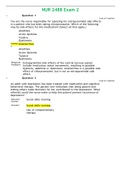Exam (elaborations)
PYC2601 EXAM PACK 2023 - DISTINCTION GUARANTEED
Well-structured PYC2601 EXAM PREPARATION PACK - DISTINCTION GUARANTEED. Contains recent exam questions and answers, and Summarised study notes. All you need to pass the OCTOBER NOVEMBER 2023 EXAMS
[Show more]





